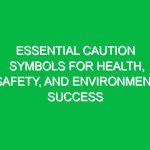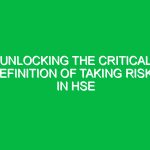Introduction
Hello everyone, and welcome to today’s Toolbox Talk! Today, we’re going to discuss an essential aspect of our work in Health, Safety, and Environment (HSE)—the concept of Three Way Communication. This method of communication is not just a technical term; it’s a crucial practice that can greatly enhance our Safety culture, improve teamwork, and ultimately prevent accidents on the job. Let’s dive into how we can implement Three Way Communication effectively in our daily operations.
What is Three Way Communication?
At its core, Three Way Communication is a communication technique that involves three parties: the sender, the receiver, and a confirmation process. This method ensures that messages are not only sent but also understood and acknowledged. In the context of HSE, this communication style is vital for ensuring that Safety information is accurately conveyed and that everyone on the team is on the same page.
For example, when a supervisor gives a safety instruction, the worker must not only hear the instruction but also repeat it back to confirm understanding. This repetition reinforces the message and minimizes the risk of miscommunication, which is a leading cause of workplace incidents.
The Importance of Three Way Communication in HSE
Effective communication is the backbone of a safe workplace. Here are several reasons why Three Way Communication is particularly important in HSE:
- Reduces Misunderstandings: By ensuring that messages are confirmed, we minimize the chances of errors due to misinterpretation.
- Enhances Team Collaboration: When team members communicate effectively, it fosters a collaborative environment that can lead to innovative safety solutions.
- Improves Safety Compliance: Clear communication helps ensure that everyone understands safety protocols, which enhances compliance with Regulations.
- Empowers Employees: Encouraging workers to communicate openly about safety concerns promotes a culture of safety and accountability.
How to Implement Three Way Communication
Now that we understand the importance of Three Way Communication, let’s explore how we can implement it in our daily operations effectively:
1. Initiate Clear Communication
Begin every communication with a clear and concise message. Avoid jargon and ensure that the information is straightforward. For instance, instead of saying, “Ensure you adhere to the PPE guidelines,” specify, “Please wear your safety helmet and goggles while working in the construction area.”
2. Encourage Active Listening
Listening is just as important as speaking. Encourage team members to listen actively by maintaining eye contact and nodding in acknowledgment. This non-verbal communication reinforces that they are engaged and processing the information shared.
3. Use Confirmation Techniques
After delivering a message, ask the receiver to repeat it back. This can be done by saying, “Can you please explain what I just told you?” This way, you can confirm that the message was understood correctly. For example, if a team leader explains a new safety procedure, the worker should articulate the steps involved to demonstrate their understanding.
4. Foster an Open Environment
Encourage questions and discussions. It’s vital that team members feel comfortable asking for clarification if they don’t understand something. Create an environment where it’s okay to speak up about safety concerns or uncertainties.
5. Reinforce Training and Refresher Courses
Regular training sessions on effective communication techniques can enhance the Three Way Communication process. Schedule refresher courses to keep everyone updated on the latest safety protocols and ensure everyone understands their role in communication.
Real-Life Examples of Three Way Communication in Action
To illustrate the importance of Three Way Communication, let’s consider a hypothetical scenario:
Imagine a construction site where a supervisor needs to instruct a worker to use a specific type of safety harness. The supervisor says, “Make sure to use the full-body harness before climbing on the scaffold.” The worker then repeats, “I need to use the full-body harness before going on the scaffold.” The supervisor confirms, “Correct, that’s the right harness.” This simple exchange ensures that the worker knows exactly what to do, reducing the risk of accidents.
In another case, let’s say a team is working on a chemical spill. The team leader communicates the plan: “We need to contain the spill using absorbent materials.” A team member responds, “We’ll use the absorbent pads from the storage container.” The leader confirms this action. This back-and-forth interaction helps ensure that everyone is on the same page and knows their responsibilities in a critical situation.
Potential Hazards and Safety Considerations
While Three Way Communication is a powerful tool, it’s essential to recognize potential Hazards associated with ineffective communication. Miscommunication can lead to:
- Accidents: If safety instructions are misunderstood, it can result in injuries or fatalities.
- Regulatory Violations: Failure to comply with safety protocols due to miscommunication can lead to legal issues and fines.
- Decreased Morale: When employees feel unsafe or unsupported due to poor communication, it can lead to dissatisfaction and high turnover rates.
Best Practices for Effective Three Way Communication
To make the most of Three Way Communication, consider the following Best Practices:
- Be Clear and Precise: Use simple language and avoid ambiguity.
- Check for Understanding: Always confirm that the message has been understood correctly.
- Use Visual Aids: Sometimes, visual aids can help clarify complex instructions or safety Procedures.
- Document Important Communications: Keep records of safety communications, especially when protocol changes occur.
Regulations and Standards
It’s important to recognize that effective communication is also a requirement under various health and safety regulations. For instance, the Occupational Safety and Health Administration (OSHA) emphasizes the importance of communication in ensuring Workplace Safety. Compliance with such regulations not only protects employees but also helps the organization avoid legal ramifications.
Conclusion
To wrap up our Toolbox Talk, remember that Three Way Communication is essential in maintaining a safe work environment. By ensuring that messages are clearly communicated, confirmed, and understood, we can significantly reduce risks and enhance our safety culture. Thank you all for your attention and commitment to safety. Let’s continue to work together to keep our workplace safe!
Before we conclude, does anyone have any questions or examples of how you’ve seen Three Way Communication make a difference in your work? Your insights are valuable as we strive for a safer work environment.


